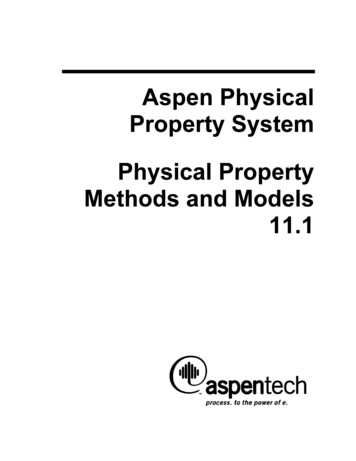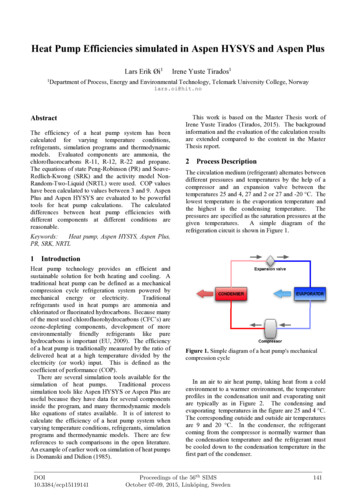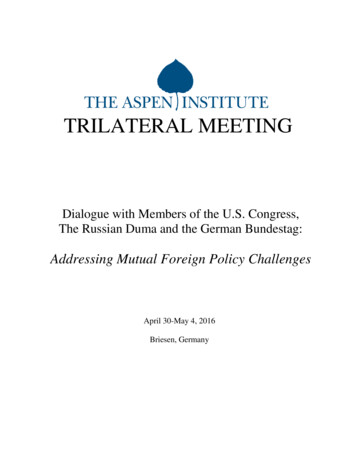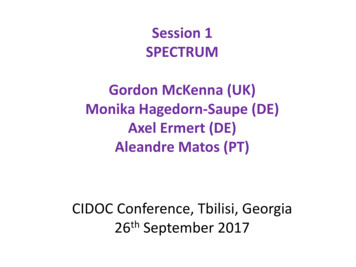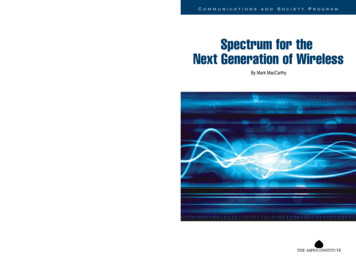
Transcription
Communications and Society ProgramMacCarthySpectrum for the Next Generation of WirelessPublications OfficeP.O. Box 222109 Houghton Lab LaneQueenstown, MD 2165811-012Spectrum for theNext Generation of WirelessBy Mark MacCarthy
Spectrum for theNext Generation of WirelessMark MacCarthyRapporteurCommunications and Society ProgramCharles M. FirestoneExecutive DirectorWashington, D.C.2011
To purchase additional copies of this report, please contact:The Aspen InstitutePublications OfficeP.O. Box 222109 Houghton Lab LaneQueenstown, Maryland 21658Phone: (410) 820-5326Fax: (410) 827-9174E-mail: publications@aspeninstitute.orgFor all other inquiries, please contact:The Aspen InstituteCommunications and Society ProgramOne Dupont Circle, NWSuite 700Washington, DC 20036Phone: (202) 736-5818Fax: (202) 467-0790Charles M. FirestonePatricia K. KellyExecutive DirectorAssistant DirectorCopyright 2011 by The Aspen InstituteThis work is licensed under the Creative Commons AttributionNoncommercial 3.0 United States License. To view a copy of thislicense, visit http://creativecommons.org/licenses/by-nc/3.0/us/ or senda letter to Creative Commons, 171 Second Street, Suite 300,San Francisco, California, 94105, USA.The Aspen InstituteOne Dupont Circle, NWSuite 700Washington, DC 20036Published in the United States of America in 2011by The Aspen InstituteAll rights reservedPrinted in the United States of AmericaISBN: 0-89843-551-X11-0121826CSP/11-BK
ContentsForeword, Charles M. Firestone.vSpectrum for the Next Generation of Wireless, Mark MacCarthyIntroduction. 1Context for Evaluating and Allocating Spectrum. 3Spectrum Policy for Commercial Use of the Spectrum . 10New Directions in Management of Federal Government Spectrum. 22Spectrum Reform Legislation. 39Conclusion. 43Further Developments after the Roundtable. 46AppendixRoundtable Participants . 55About the Author. 59Select Publications from the Aspen InstituteCommunications and Society Program. 61About the Communications and Society Program. 67iii
This report is written from the perspective of an informed observer at theAspen Institute Roundtable on Spectrum Policy. Unless attributed to a particular person,none of the comments or ideas contained in this report should be taken as embodying theviews or carrying the endorsement of any specific participant at the Roundtable.
ForewordIt is clear that demand for spectrum will only increase in the comingyears. Wireless devices are flooding the market, with greater demandsfor text, audio and video use of the spectrum. Indeed, estimates rangeup to 500 MHz of spectrum that the wireless industry could use tomake the dream of wireless broadband a reality in the United States.The 2010 Aspen Institute Roundtable on Spectrum Policy (AIRS), “TheSearch for 500 MHz: Spectrum for the Next Generation of Wireless”met in the fall of 2010 to address where and how that spectrum can berepurposed for wireless uses.After exploring the apparent hockey-stick demand for more spectrum in the years ahead, participants addressed how users would findnew sources of (or more efficient ways of using) this valuable resource.But rather than just look at the usual places one-by-one, the group tooka broader, more strategic approach. It encouraged longer range plansto create mechanisms and processes for allocating both commercial andgovernment spectrum. This would involve allocating budget to longerrange planning and leadership from the Administration, perhaps atthe Office of Science and Technology Policy in the White House, aswell as the Federal Communications Commission and the NationalTelecommunications and Information Administration. Participantsalso liked the idea of an innovation fund within the government toencourage inter-governmental sharing and increased efficiency.With respect to commercial spectrum, the group (though not unanimously) favored the concept of two-sided incentive auctions to encourage existing licensees who may not need all of their spectrum to sell theunneeded portions in auctions that would return some proceeds to thecurrent licensee and some to the government. Broadcasters remainskeptical of the plan at this writing, but the proposal is for voluntary,not forced, entry into the auction. Participants also tended to favormore flexible use of spectrum already held for one purpose to be usedfor more efficient or higher yielding purposes. Like most areas of spectrum management, however, there are limitations and caveats such asthe need for national and international coordination of the spectrumfor certain uses, and the constraints of equipment.v
viSpectrum for the Next Generation of WirelessThe FCC and NTIA have considerable powers in this area, but mostof these concepts, and many other proposals and solutions discussed—such as creating “overlay” licenses where parties could secure rights,essentially, to bargain with others to clear or use their spectrum—willneed Congressional authorization. While that is always difficult dueto the complexity of the subject matter and the relatively low placespectrum resides on the legislative priority list, the coming monthsand years may be different. Spectrum auctions bring money to theTreasury, and as legislators look to reduce deficits, the auctioning ofspectrum may be a tempting target.The Roundtable, then, offered a number of solutions to the spectrum crunch ahead, and even considerable hope that government officials will act to meet this challenge for the next generation of wireless.AcknowledgmentsI want to take this opportunity to thank our sponsors for makingthis Roundtable possible: AT&T Services Inc., Cisco Systems, ComcastCorporation, Credit Suisse, Ford Foundation, Google, Intel Corporation,John S. and James L. Knight Foundation, Liberty Global Inc., LockheedMartin, Microsoft Corporation USA, National Association ofBroadcasters, Qualcomm Incorporated, Regulatory Source AssociatesLLC, Stifel Nicolaus, T-Mobile, Verizon Communications, and theWireless Innovation Forum. A special thank you goes to MarkMacCarthy, our rapporteur, for his informative account of the conference discussions.Finally, I want to thank Sarah Eppehimer, Senior Project Manager,and Ian Smalley, Program Associate, for producing the conference andthis report, along with the Communications and Society Program’sAssistant Director Patricia Kelly, who oversaw its editing and publication.Charles M. FirestoneExecutive DirectorCommunications and Society ProgramThe Aspen InstituteWashington, D.C.May 2011
Spectrum for theNext Generation of WirelessMark MacCarthy
Spectrum for the Next Generation of WirelessMark MacCarthyIntroductionIn November 2010, the Aspen Institute Communications and SocietyProgram held the latest in its continuing series of roundtable discussionson spectrum policy, “The Search for 500 MHz: Spectrum for the NextGeneration of Wireless.” The Roundtable brought together technicalexperts, industry representatives, congressional staff, officials from theExecutive Office of the President and the National Telecommunicationsand Information Administration, industry analysts, officials from foundations and public interest groups, and academics.The conference found its inspiration in the proposal of the FederalCommunications Commission (in its 2010 National Broadband Plan)and the executive branch to find 500 MHz of spectrum to satisfy theincreasing demand for wireless broadband services. Participants largelyfocused on longer term strategic plans to more efficiently allocate spectrum for both commercial and governmental use. There was generalconsensus that the current political situation presents an unusual strategic opportunity to move institutions that allocate and use spectrumtoward more flexible and nimble mechanisms.The group generally concluded that granting the FederalCommunications Commission the authority to hold incentive auctionssatisfying certain conditions would represent a major step forward. Itwould allow marketplace participants to determine the uses of spectrum in ways that regulators, technicians and economists would simplybe unable to foresee and plan for. In its National Broadband Plan,released in March 2010, the Federal Communications Commissionrecommended it be given express authority to hold auctions in whichthe incumbent licensees relinquish rights to other parties in return fora share of the auction proceeds. The U.S. Treasury would be the beneficiary of the remaining portion of the proceeds. The current politicalsituation puts a premium on measures to reduce the national budget1
2Spectrum for the Next Generation of Wirelessdeficit, creating an opportunity for Congress to move ahead withincentive auction authority in a way that allows all parties to benefit.The group also looked favorably on further use of the FCC’s authority to allow more flexible use of spectrum for a larger range of purposes than those for which the spectrum was originally allocated. Thisflexible-use policy could create the opportunity for incumbents to usethe spectrum for innovative purposes or to sell it to others interested inthese new uses. The group was concerned that the unlimited use of thisauthority, however, might create difficulties in managing interferenceand coordinating spectrum use internationally.The group considered combining this flexible-use policy with theFCC’s overlay auction authority. In an overlay auction, the FCC auctions spectrum in and adjacent to the assigned spectrum and allowsthe auction winner to negotiate with the incumbent to clear the spectrum. This provides incumbents with an incentive to allow or engagein repurposing of the assigned spectrum, and allows other marketplaceparticipants to assess whether there are newer, more valuable uses ofthe spectrum. Although the revenue from the overlay auctions goesto the Treasury, bidders are presumably willing to pay less for theencumbered spectrum than they would for the cleared spectrum in anincentive auction.There was substantial discussion of the need for auctions to meetequity and efficiency goals by including the full participation of smallbusinesses and other designated entities and also by ensuring thatauction results preserved workable competition. Some parties wereconcerned, however, that such arrangements would be unnecessary orcounterproductive or might reduce auction revenue.On the governmental side, the group endorsed the idea of longrange strategic planning for major systems that would involve boththose who acquire the systems and those involved in spectrum management. Current reviews are short-term, take existing rules as a given andfocus on compliance, and are limited to single agencies or departments.The strategic review called for here would require additional budget forlong-term planning. The group discussed who should conduct strategic inventories and measurements of existing uses, considering bothoutside independent audits and reviews conducted by the NationalTelecommunications and Information Administration (NTIA). The
The Report3group agreed that strategic direction would have to come from theWhite House through an agency such as the Office of Science andTechnology Policy (OSTP), with NTIA as the longer-term enabler of acollaborative process.The group also embraced improvements in the CommercialSpectrum Enhancement Act (CSEA). This act currently allows revenue from previous auctions of government spectrum to be used for avariety of purposes, including conversion and relocation expenses forincumbent federal spectrum users. The recommended improvementswould provide funds for planning and demonstration, liberalize thestandard under which funds could be used for new equipment, providea research and development budget for interference tolerance or mitigation, and include incentives for government to obtain services fromcommercial suppliers where appropriate.Finally, the group advocated the development of an innovation fundto catalyze thinking on improvements in spectrum efficiency. This fundwould provide for pilot programs for spectrum sharing with other government agencies or with commercial parties and identify obstacles toadoption.Participants considered the role of Congress in approving new legislation that would embody these suggested reforms. While the windowfor successful action might be narrow, the group was confident that acomprehensive bill that would embody incentive auctions and fundingfor long-term strategic spectrum planning in government, improvements in CSEA and an innovation fund was a realistic possibility.Funding for improved management of the federal spectrum use shouldbe derived from set-asides from spectrum auctions, device certificationfees, and any spectrum use fees. The group also discussed the possiblerole of the FCC in moving separately and directly to increased flexibleuse and overlay auctions.Context for Evaluating and Allocating SpectrumEvery society that uses the electromagnetic spectrum for the transmission of information has to have a process for allocating it forparticular uses and assigning it to people to use it. Once the technological capacity to use the spectrum for communications purposes wasdeveloped, the spectrum transformed from a natural phenomenon to
4Spectrum for the Next Generation of Wirelessa common economic resource. Like individuals in John Locke’s stateof nature, societies face the problem of how to pull elements of thisresource out of the commons. How could it be appropriated for productive use?Almost all societies solved this problem in the same way. Variousprocesses of government divided up the spectrum into usable portions,determined the appropriate use of each portion and designated particular parties as those entitled to the exclusive use of it for those purposes.In some cases, those entitled to use the spectrum were private parties;in other cases, government agencies. In the case of private spectrumusers, transfers were permitted, but only to others who would use it forthe same purposes.All users were given the legal right to protection against physicalinterference with their assigned use of the spectrum. Early attemptsto leave government out of the spectrum management process in theUnited States resulted in such chaos from interference that the nascentbroadcasting industry eagerly sought protection from this interferencethrough pervasive government regulation. In fact, the technical characteristic that the spectrum was a rivalrous but non-excludable good persuaded almost everyone that government had to manage this resourceclosely if it were ever to become a usable economic resource. Failureto allocate uses and restrict access would only result in a tragedy of theelectromagnetic commons.This was the situation observed by Ronald Coase, who, in his famous1959 article, made the case for treating the electromagnetic spectrumless like a commons to be managed centrally and more like a typicaleconomic resource.1 Government, according to this perspective, shouldassign property rights in spectrum to commercial entities who would beable to use them for a wide variety of economic purposes. It should focuson resolving disputes that might arise between spectrum users.The discussion at the conference was heavily influenced by this perspective and its emphasis on the practical reality that government spectrum management must provide a process for taking into account unpredictable developments in technology, business strategies and the relativestrength of demand for competing services. The dialogue also drew uponan awareness of developments in technology, including the prospect of“smart” radios that may bring more nimble approaches to spectrum
The Report5management than the nearly 100-year-old allocation approaches.Beyond this deep background, a number of other developmentsprovide a context for the deliberations of the conference participants.2002 Report of Spectrum Policy Task ForceIn 2002, the Federal Communications Commission SpectrumPolicy Task Force Report recommended that flexible use of the electromagnetic spectrum should be the regulatory norm, subject to several constraints including provision for public safety, protection frominterference and compliance with treaty obligations.2 The discussion atthe conference built upon the framework developed in this visionaryreport and attempted to apply this perspective to the current spectrummanagement challenges.2010 National Broadband PlanThe Federal Communications Commission released its congressionally mandated National Broadband Plan in March 2010. Chapter5 of the report focused on spectrum issues and made several specificrecommendations3 including that the FCC make available 500 MHz ofspectrum suitable for wireless broadband use within 10 years and 300MHz for mobile use within 5 years.The conference made specific recommendations for achieving the300 MHz goal: 20 MHz from the Wireless Communications Service band10 MHz from the Upper 700 MHz D block60 MHz from the Advanced Wireless Services band90 MHz from terrestrial deployment of Mobile Satellite Spectrum120 MHz from the broadcast television bandsTo achieve this goal, participants also called on Congress to expand“the FCC’s authority to enable it to conduct incentive auctions.” In anincentive auction, the spectrum assigned to a licensee is auctioned andthe incumbent licensee receives a portion of the proceeds of the auction. The report also proposed as a fall back mechanism, if Congressdid not provide incentive auction authority or if incentive auctions did
6Spectrum for the Next Generation of Wirelessnot succeed, the use of overlay auctions. In such cases, the FCC woulduse its existing authority to auction spectrum in and around assignedspectrum and allow the incumbent licensee to negotiate with the auction winners to determine the use of the spectrum.These goals and the use of incentive auctions or overlay auctions toachieve them were a major focus of the conference discussions.2010 Presidential DirectiveIn June 2010, the White House released a presidential memorandum4directing executive departments, agencies and offices to work with theDepartment of Commerce and the FCC to make available a total of 500MHz of spectrum over the next 10 years suitable for wireless broadbanduse. The Commerce Department was required to complete a plan andtimetable by October 1, 2010 for making available this spectrum.In a speech the same day, Lawrence Summers, head of the NationalEconomic Council, emphasized that this drive for additional spectrumwas made urgent by the threat of a “spectrum crunch” that might failto keep up with the demand for mobile data usage, which he estimatedat between 20 and 45 times 2009 levels.5 He described the President’sspectrum plan as consisting of four parts: Identify and plan for the release of 500 MHz of spectrum—from both private and government hands Provide new tools and incentives to free up spectrum—including incentive auctions Redeploy spectrum to high-value uses—which he identified asfor wireless broadband Use auction proceeds to promote public safety and job-creating infrastructure2010 FCC Spectrum SummitOn October 21, 2010, the FCC held a spectrum summit focusing onmobile broadband and addressing ways to ensure that there was enoughspectrum to accommodate the increased demand for mobile datausage. In a speech at the summit, FCC Chairman Julius Genachowski,
The Report7noted the existence of a “looming spectrum crunch” being driven by alikely “35X increase in mobile broadband traffic over the next 5 years”and the resultant need for an additional 300 MHz of spectrum by 2014to meet this demand. He announced that the FCC had already recovered 25 MHz from the Wireless Communications Service band and hadproposed rules to recover 90 MHz from Mobile Satellite Services band.He urged “swift action” by Congress to authorize incentive auctions,and he announced several items on the FCC’s November 2010 agendato respond to the spectrum crunch: A notice of proposed rulemaking that would lay essentialgroundwork for incentive auctions quickly should Congressact, looking at lifting technical restrictions so broadcast spectrum could be used for broadband A notice to expand the FCC’s experimental licensing programincluding easing testing restrictions on institutions that aredeveloping new services and devices that utilize spectrum A notice of inquiry to accelerate opportunistic uses of spectrum, including technological advances that enable greater useof secondary marketsDepartment of Commerce ReportsOn November 15, 2010, the Department of Commerce released tworeports.The first was a Fast Track Evaluation. This report “examined fourspectrum bands for potential reallocation within 5 years: (1) 1675–1710MHz, (2) 1755–1780 MHz, (3) 3500–3650 MHz, and (4) 4200–4220MHz and 4380–4400 MHz.” It recommended that “various portionsof these bands totaling 115 megahertz be made available for wireless broadband use within 5 years, contingent upon the allocation ofresources for necessary reallocation activities.”6The second report was a 10-year plan and timetable that respondedto President Obama’s presidential directive calling for 500 MHz ofspectrum to be made available for wireless broadband. It identified2,200 MHz of federal and non-federal spectrum suitable for evaluation
8Spectrum for the Next Generation of Wirelessand possible release for wireless broadband over the next 10 years. Ofthis 2,200 MHz of candidate spectrum, “28 percent is allocated exclusively for federal use at present, 35 percent is allocated exclusively forcommercial use, and 37 percent is shared by federal and commercialusers.” This amount includes “280 MHz of commercial spectrum thatthe FCC recommended in its National Broadband Plan be made available for mobile broadband use within 5 years.”7The report reiterated the administration’s call for incentive auctionsand recommended changes to the Commercial Spectrum EnhancementAct, the use of prizes and awards to improve spectrum efficiency, andan increased role for the Commerce Spectrum Management AdvisoryCommittee.Industry and FCC AnalysesParticipants at the conference also had before them a number ofreports and industry developments that influenced their discussions.The first was the Bazelon Report, released in October 2009.8 This reportconcluded that 62 billion worth of broadcast spectrum could be madeavailable for mobile broadband at a fully compensatory cost of 12billion. This estimate suggested that the gains from allowing trades inbroadcaster spectrum would probably be substantial.The FCC released a report on mobile broadband in October 2010.9It examined industry projections of the demand for wireless broadbandusage and adopted the average projection of 35 times 2009 levels by2014. The vast majority of the increases in projected wireless broadband usage would be for mobile video.10 Even if the industry continues to increase network density by increasing the number of cell sitesat the current growth rate of seven percent per year and even takinginto account increases in spectral efficiency from the new generationof wireless mobile, the report projects a spectrum deficit for wirelessbroadband of 275 MHz by 2014. If the industry attempted to meetprojected demand by investing in additional cell sites over and aboveits current growth rate of seven percent, it would cost an additional 120 billion. This figure gives an estimate of the economic advantagesin terms of cost savings that would accrue if additional spectrum weremade available to fill the wireless broadband spectrum deficit.
The Report9Tiered PricingIn 2010 the wireless broadband industry moved in the direction oftiered pricing. For instance, in June, one carrier announced a tieredpricing model for wireless data services that charges users 15 for 200MB of data and 25 for 2 GB.11 The need to provide appropriate economic incentives for heavy users of video programming appears to bedriving these tiered pricing arrangements.12 Other carriers are poised tofollow suit, and the FCC is unlikely to stand in the way of these plans.13The FCC’s Mobile Broadband report noted that these new pricingstrategies have “the potential to impact data traffic projections if widelyadopted in the market.”14 The National Broadband Plan warned, however, that “it would not be wise for America to bet its mobile future ona strategy of ‘demand reduction.’”152010 GAO reportThe Government Accountability Office issued a report on competition in the wireless industry. It concluded that four large national wireless phone service carriers—AT&T, Sprint, T-Mobile and Verizon—currently operate alongside small and regional carriers of various sizes.The four large national carriers serve more than 90 percent of wirelesssubscribers, though no single competitor has more than one-third ofthe national market.16 In March 2011, AT&T and T-Mobile announceda proposed merger of their wireless operations.Political DevelopmentsIn the 2010 mid-term elections, Republicans won control of the U.S.House of Representatives and narrowed the Democratic majority inthe U.S. Senate. According to many analysts, concern about government spending and deficits fueled this electoral victory. Shortly thereafter, an initial recommendation from the co-chairs of the NationalCommission on Fiscal Responsibility and Reform contained specificplans for deficit reduction. Renewing the FCC’s auction authority wasone of these recommendations, although no estimate of revenue wasprovided.17 These political developments created an unusually strongfocus on deficit reduction. Participants in the conference were awarethat revenue from spectrum auctions would be a politically attractivestrategy to reach this goal.
10Spectrum for the Next Generation of WirelessSpectrum Policy for Commercial Use of the SpectrumIn 2002, the Federal Communications Commission Spectrum PolicyTask Force Report recommended that flexible use of the electromagnetic spectrum should be the regulatory norm, subject to several constraints including provision for public safety, protection from interference and compliance with treaty obligations.18In many ways, the discussion at the conferenceMeeting unanticipated surges mirrored these conclusions.The search for 500 MHz of spectrum wasin demand willthe framing question for the conference, butrequire somethe discussion seemed to go back to the morebasic question of the right regulatory framething morenimble than the work for allocating spectrum to take accountof the fact that new and attractive uses of speccurrent slowtrum are essentially unpredictable. For examspectrumple, the huge success of smartphones, such asBlackberries and iPhones, was unanticipated.reallocationMeeting these unanticipated surges in demandprocess.will require something more nimble than thecurrent slow spectrum reallocation process. The conference was notseeking a solution to the immediate problem of wireless broadbandspectrum—otherwise policymakers will be back in the same predicament in 10 years. Instead, the discussion focused on whether this goalof greater availability of spectrum suitable for wireless broadband couldbest be accomplished through incentive auctions, overlay auctions orflexible use. These more nimble mechanisms could then be used toavoid spectrum shortages in the future. The looming broadband wireless spectrum crisis provided the occasion for deeper reflection on morefundamental reform.Demand for Wireless BroadbandThe participants reviewed the October 2010 FCC mobile broadbandreport and raised some pointed questions about the evidence. Whilethe industry estimates of the growth curve in mobile traffic all showdramatic increases in demand, varying from 23 times 2009 levels to47 times 2009 levels by 2014, to some participants the FCC’s choice of
The Report11the average seemed to be no more than arbitrary and imprecise guesswork that could under or overestimate the economic consequencesby billions of dollars. It is possible that increasing system capacity tomeet demand for wireless broadband could be met by creating smallercell sizes through increased investment in fiber.19 The FCC report discussed this fiber-intensive, smaller-cell-size alternative and estimatedthat it would be more expensive than providing additional spectrum.However, there is debate about the reliability of these alternative costestimates. In addition, the FCC report did not undertake an analysisof the net social benefits of making more spectrum available for wireless broadband. As a result, there was no assessment of whether otheruses of the spectrum might provide greater advantages in terms ofjobs, equity, reduction in the digital divide and trade benefits. Someparticipants questioned whether the drive for making more spectrumavailable for wireless broadband could be justified in the absence of thislarger analysis.Participants spent some time discussing a change in the networkarchitecture to shrink cell size. One way to do that would be throughthe use of femto cells, which are low-power, short-range base stationsthat users connect to a wireline broadband connection to expand coverage within a home or office. Participants discussed the idea of shrinking cell sizes b
for long-term strategic spectrum planning in government, improve-ments in CSEA and an innovation fund was a realistic possibility. Funding for improved management of the federal spectrum use should be derived from set-asides from spectrum auctions, device certification fees, and any spectrum use fees. The group also discussed the possible


